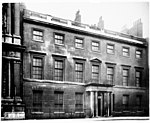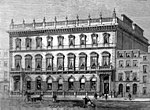Royal Automobile Club
1897 establishments in the United KingdomAutomobile associations in the United KingdomGentlemen's clubs in LondonGrade II* listed buildings in the City of WestminsterOrganisations based in the United Kingdom with royal patronage ... and 1 more
Use British English from August 2017

The Royal Automobile Club is a British private social and athletic club. It has two clubhouses: one in London at 89 Pall Mall, and the other in the countryside at Woodcote Park, near Epsom in Surrey. Both provide accommodation and a range of dining and sporting facilities. The Royal Automobile Club has some female members. It is best-known for establishing the roadside assistance service RAC Limited, though this is no longer owned by the club.
Excerpt from the Wikipedia article Royal Automobile Club (License: CC BY-SA 3.0, Authors, Images).Royal Automobile Club
St. James's Street, City of Westminster Victoria
Geographical coordinates (GPS) Address External links Nearby Places Show on map
Geographical coordinates (GPS)
| Latitude | Longitude |
|---|---|
| N 51.5062 ° | E -0.1349 ° |
Address
Royal Automobile Club
St. James's Street 88 - 91
SW1Y 5HS City of Westminster, Victoria
England, United Kingdom
Open on Google Maps









